Roles in court
Have you ever wondered what a courtroom looks like in a criminal trial?
The diagram above shows the main players in a criminal trial by jury in the District Court and Supreme Court. Find out who's who in court by reading the descriptions below.
1. Accused person or defendant
A person who must defend his or her actions in court. They may be defending themselves against a criminal or civil charge or have had a court claim for money brought against them. In a criminal trial in the District Court and Supreme Court, a defendant is called the accused. The accused/defendant can represent themselves but can also have a solicitor or barrister represent them. They usually sit behind the bar table or in a section called the dock if they are in custody.
2. Audio Visual Link (AVL)
AVL enables remote participation for judges, lawyers, witnesses, and defendants through video and audio feeds.
3. Court officer
Helps the judicial officer and people coming into the courtroom. The court officer organises court lists, calls witnesses and administers oaths.
-
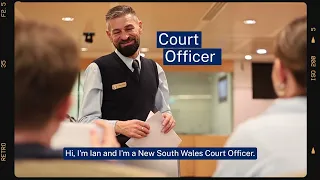
Step inside the courtroom with Ian, a Court Officer who's always on the move.
Meet a Court OfficerStep inside the courtroom with Ian, a Court Officer who's always on the move.
TranscriptHi, I’m Ian and I’m a New South Wales Court Officer. Many people don’t know this but without Court Officers the courtroom would be pretty inefficient. We do a lot of roles in the court. I guess you could say I’m the go between for everyone, from judges to jurors to lawyers to the public. I call and sweat in witnesses, manage and record evidence and ensure confidentiality is maintained. I also operate courtroom technology to keep things running smoothly. Importantly, when the jury reach a decision in court matters, it’s my job to pass on the verdict to the judge to be announced. But the biggest difference I feel my role makes is looking after jurors. Court Officers act as the jurors main point of contact during the trial. We are there to ensure they have a safe and positive experience with what can be a really challenging job. Knowing I made their experience a little bit easier is really rewarding to me.
4. Court reporter or Sound reporter
Court staff member who records the hearing and writes down or types what is being said.
-
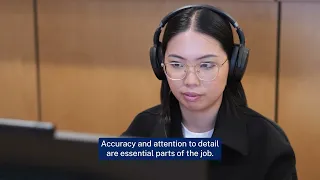
You won't always see Jess in court, but you can guarantee she's listening. As a Sound Reporter Dual Remote she works both in & out of the courtroom.
Meet a Sound ReporterYou won't always see Jess in court, but you can guarantee she's listening. As a Sound Reporter Dual Remote she works both in & out of the courtroom.
TranscriptHi, I’m Jessica. I’m a Sound Reporter in the New South Wales Courts. I record audio in a courtroom and turn it into a transcript. This is used by lawyers, judges, police and anyone in the courtroom who applies for it. Court can move really quickly with a lot of legal terms. Sound Reporters note down key point and facts to assist with efficient transcription later. Our work makes sure that everyone has access to the same information throughout court proceedings. Accuracy and attention to detail are essential parts of the job. It’s really unique job because we play an invisible but vital role in the courtroom. Our contribution makes an important impact of our justice system.
5. Corrective services officer
Provides transport and security for people in custody.
6. Defence lawyer
Represents the defendant or accused person. Sometimes several defence lawyers represent the accused person. In the District Court and Supreme Court the defence barrister may wear a wig and gown.
Meet Mark, a defence lawyer at Legal Aid NSW. He leads a team that provides legal support to people in the community.
-
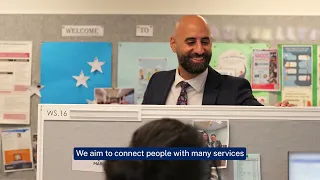
Meet Mark, a defence lawyer at Legal Aid NSW. He leads a team that provides legal support to people in the community.
Meet a Defence Lawyer from Legal Aid NSWMeet Mark, a defence lawyer at Legal Aid NSW. He leads a team that provides legal support to people in the community.
TranscriptHi, I'm Mark and I'm a criminal defense lawyer and solicitor in charge of a legal aid New South Wales office. My team and I provide legal representation to eligible people who have difficulties accessing crucial legal services. Our primary purpose is to present our clients case to the court to ensure their voices are heard fairly. The circumstances surrounding our clients lives can be a big contributor to their contact with the courts. We aim to connect people with many services thathelp support them through their court journey and help reduce future contact with the justice system. Being involved in a legal matter can have significant impact on people's lives. At the end of the day, I'm proud knowing that we have provided a highquality service to our clients whilst honoring the rule of law.
7. Interpreter
Assists the court by translating speech from one language into another or by translating sign language into speech.
-
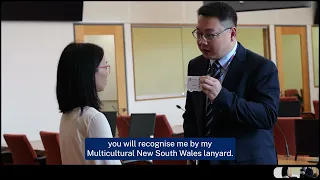
How do you navigate the justice system when you speak limited English? With the help of people like Shiyi.
Meet an InterpreterHow do you navigate the justice system when you speak limited English? With the help of people like Shiyi.
TranscriptHi, I'm Shiyi, a certified mandaring interpreter in the multicultural New South Wales. I interpret for people with limited English in New South Wales courts. My role ensures that everyone is heard and could express themselves clearly. This ensures fairness and understanding in legal proceedings. Interpreting isn't just about the words. Actually, it's about the meaning and ensuring accuracy and completeness. I don't explain the legal system, nor do I take sides, but I'm here to support understanding for everyone. As an officer of the court, you will recognize me by my multicultural New South Wales lanyard. For me, success is seeing the spark of understanding in someone's eyes. And when I know they have been heard by the court, I know I've done my job well when the court gets unbear. Why? Because communication flows smoothly.
8. Judge or judicial officer
In the District Court and Supreme Court, the judicial officer is called a judge. You call a judicial officer 'Your Honour' when you are in court. In the Local Court the judicial officer is a magistrate.
9. Judge's associate
Helps the judge in court with documents and exhibits used in the case.
-
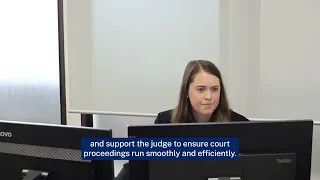
Meet Abbey, a Judge's Associate. She's the Judge's 'right-hand person' behind the scenes and in court.
Meet a Judge's AssociateMeet Abbey, a Judge's Associate. She's the Judge's 'right-hand person' behind the scenes and in court.
TranscriptI’m Abbey, and I’m a Judge’s Associate. Making sure everything is ready for the judge to step onto the bench takes a lot of effort behind the scenes. That’s where I come in. I assist with legal research, draft judgements and support the judge to ensure court proceedings run smoothly and efficiently. Being in court is only one part of the job but it’s definitely the most enjoyable. It’s a great opportunity to observe the decision-making process up close and personal. We’re the legal nerds. We get to see and do everything that the judge does but we don’t have the pressure of making the decision.
10. Jurors
Citizens who sit on a jury and consider the evidence in court and decide on matters of fact. The jury is selected at random from the public and their job is to deliver a verdict on the case. In a criminal trial there is typically a jury of 12 people but in some cases there may be additional jurors. In civil cases there is typically a jury of four people. Cases in the Local Court are heard without a jury.
11. Media
Representatives from the press, television and online services can attend most court proceedings, except those in the Children's Court.
12. Prosecutor
Represents the police or the Crown in criminal matters. In the Local Court, the prosecutor is a specially trained police officer. In the District Court and Supreme Court, the prosecutor is a lawyer from the Office of the Director of Public Prosecutions.
-
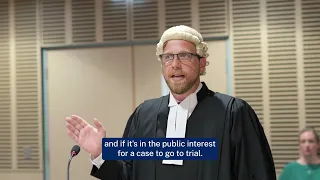
Crown Prosecutor Carl deals with serious crime in NSW. If a case goes to trial he presents evidence to a judge or jury on behalf of the people of NSW
Meet a Crown ProsecutorCrown Prosecutor Carl deals with serious crime in NSW. If a case goes to trial he presents evidence to a judge or jury on behalf of the people of NSW
TranscriptHi, I'm Carl and I'm a crown prosecutor working with the Office of the Director of Public Prosecutions. When someone is charged by the police with a serious crime, their case usually comes to us. We work with a set of rules called prosecution guidelines to determine if there is enough evidence and if it's inthe public interest for a case to go to trial. If there is, I present that case to a judge or a jury. My job is aboutpresenting the evidence so that a judgeor jury can make an informed decision about the guilt or innocence of the person accused of a crime. My job isn't about winning or losing. It's about helping the court reach a decision in a fair and just way.
13. Public
Members of the public are allowed into the public galleries of courtrooms in New South Wales to watch most cases. However, some cases, including all Children's Court cases, are closed to the public.
14. Sheriff's Officer
Maintains the security of courtrooms and complexes and ensures the safety of all people in attendance at court.
-
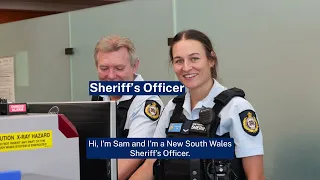
For Sam, client service is at the heart of the job of a Sheriff's Officer. Tasked with making sure people have a safe and fair experience in court.
Meet a NSW Sheriff's OfficerFor Sam, client service is at the heart of the job of a Sheriff's Officer. Tasked with making sure people have a safe and fair experience in court.
TranscriptHi, I'm Sam and I'm a New South Wales Sheriff's Officer. It's my job to keep everyone safe at court and make sure they understand and follow the rules. I'm often the first person people see and interact with as they walk through the door. Client service is at the heart of what we do. We make sure everyone has a safe and fair experience when attending court. There are many times in my career where saying the right thing at the right time can deescalate a stressful situation. Sometimes though, there's more than what you see at the courthouse. We perform evictions, make arrests, enforce court orders, and recover debts. My team and I take pride in showing our clients both respect and compassion, especially when it can be a difficult time in their lives. I'm proud to be a Sheriff's Officer and doing my part in protecting the New South Wales justice system.
15. Support people
Come to court to offer support to particular witnesses. They are chosen by particular witnesses, but do not play a role in court proceedings.
16. Witness
Someone who gives evidence in a case. Witnesses answer questions asked by the prosecutor and the defence. Before giving evidence, each witness is asked to take an oath or affirmation, which is a promise to tell the truth.
Court Registrar
Oversees the daily operations of the courthouse, including case scheduling, record keeping, and client service. Leads a team to ensure court processes run smoothly and that clients are supported throughout their court experience.
-
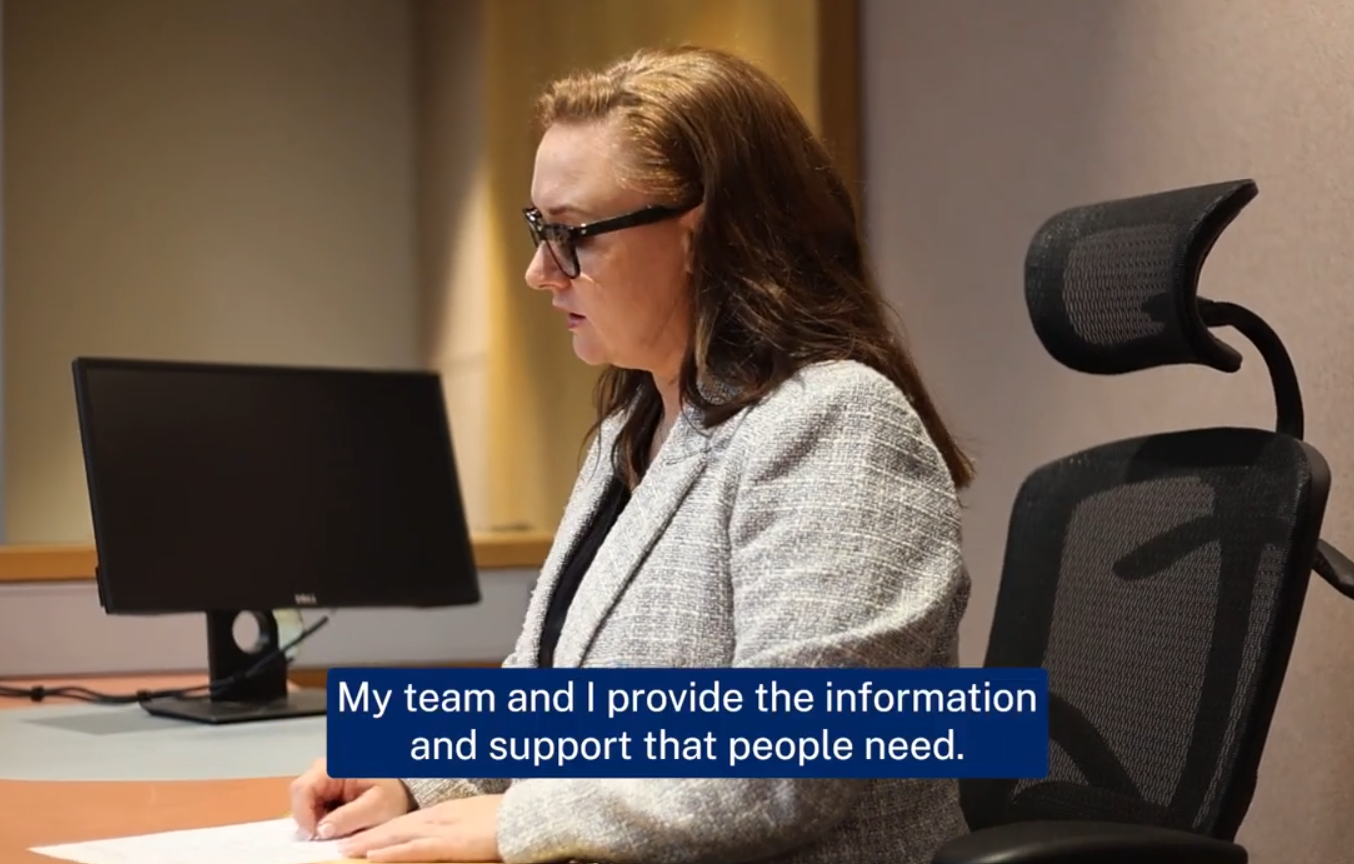
As a Court Registrar, Holly knows everything there is to know about the courthouse. Take a look behind the scenes to see how it runs smoothly.
Meet a Court RegistrarAs a Court Registrar, Holly knows everything there is to know about the courthouse. Take a look behind the scenes to see how it runs smoothly.
TranscriptHi, I'm Holly and I'm a Court Registrar.
Day-to-day, I oversee the running of the courthouse and everything that happens in it.
This includes people management, record keeping, ensuring the effective operation of the court and of course, customer service.
The first time people come into the court, they might see me in the courtroom. I make sure court proceedings and paperwork are prepared and in order and schedule a time for the case to be heard by the judge.
My team and I provide the information and support that people need.
I enjoy supporting our clients to have a good experience with the justice system.
Last updated:
We acknowledge the traditional owners and custodians of the land on which we work and we pay respect to the Elders, past, present and future.